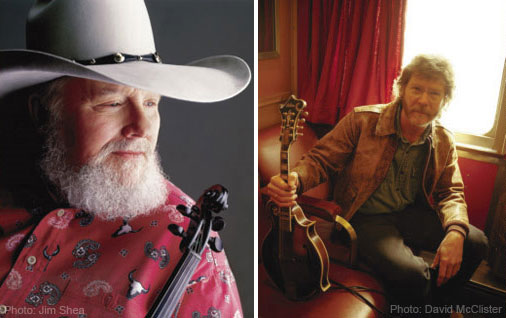
CHARLIE DANIELS
In 1959, with his instrumental rock combo, the Jaguars, Daniels recorded his first album (produced by Bob Johnston), which was picked up for national distribution by Epic Records. Johnston and Daniels co-wrote “It Hurts Me,” which appeared as an Elvis Presley B-side. Daniels moved to Nashville in 1969 to work as a session guitarist (notably on three Bob Dylan albums, including Nashville Skyline), produced albums by the Youngbloods, and toured Europe with Leonard Cohen.
In 1970, his first solo album and the newly-formed Charlie Daniels Band helped usher in the first wave of southern rock, and Daniels’ career took off in 1973 with the hit “Uneasy Rider.” With rebellious songs of anthemic proportions, Daniels’ 1975 album Fire on the Mountain went double platinum. In 1979 Daniels released his Grammy-winning crossover hit “The Devil Went Down to Georgia,” which garnered three Country Music Association trophies and turned the album Million Mile Reflections triple platinum. The album’s title referenced Daniels’ extensive touring with an exponentially growing band, including a full horn section, a troupe of clog dancers and, at times, a gospel choir. By 1981, the band had twice been named Touring Band of the Year by the Academy of Country Music. Daniels’ own incredible live energy is perfectly showcased in 2008’s DVD release Preachin’, Prayin’, Singin’ with Charlie Daniels & Friends: Live From Nashville.
Starting in 1974, Daniels organized the first of many world-famous Volunteer Jam concerts, which hosted a lengthy list of renowned stars and served as the model for today’s annual day-long music events. In 1998 Daniels received the Pioneer Award from the Academy of Country Music and in 2008 achieved his lifelong dream of being inducted as a member of the Grand Ole Opry. With a career spanning over 50 years and a catalogue of over 50 recorded projects, touching genres from folk and country to rock and jazz, Daniels is a music industry veteran, and he has the lengthy list of accolades to prove it.
When asked what he’s most proud of, Daniels responded: “Keeping 25 people gainfully and steadily employed for over 30 years. We have health insurance, a 401K plan and people here for 38 years. I care about them, they take care of me. That’s pretty doggone neat.”
SAM BUSH
Born April 13, 1952 in Bowling Green, KY, Sam Bush owned his first mandolin at 11, won consecutive National Oldtime Fiddlers’ Contests at ages 15, 16 and 17, and debuted on the Grand Ole Opry stage at 17, so it’s safe to say he quickly rose to the top of the bluegrass world. Fusing traditional bluegrass with rock, country, jazz, and reggae, Bush formed the New Grass Revival and pioneered a fresh sound and genre name. Now Bush reigns as the King of Newgrass, “the wild bluegrass stepchild” genre characterized by rock grooves and extended jams.
The New Grass Revival set the standard for newgrass from 1971 to 1989 and toured with acts like Leon Russell and the Grateful Dead, while producing over a dozen albums. Upon the dissolution of the New Grass Revival, Bush toured and recorded with Emmylou Harris’ Nash Ramblers for the next five years, then toured with Lyle Lovett and his old New Grass Revival bandmate, Béla Fleck.
While one of the most in-demand sidemen for some of the best in the business, Bush has also maintained a steady solo recording career. He released his first solo album, Late as Usual (his wife claims he runs on “Sam Bush Time”), in 1985, while still a member of the New Grass Revival. Since then, he released Glamour & Grits in 1996, followed by Howlin’ at the Moon in 1998, King of My World in 2004 and Laps in Seven in 2006. As you would expect from a virtuosic performer like Bush, he continues to tour extensively, documenting his fiery live performances with Ice Caps: Peaks of Telluride (2000) and, most recently, 2007’s On the Road DVD.
Fans can be thankful that a teenage Bush, jamming with a mandolin, ignored his hero Bill Monroe’s advice: “Boy, stick to the fiddle,” for, like Monroe himself, Sam Bush has thrust bluegrass into another new era.
![]()
Elmore: What are you listening to right now?
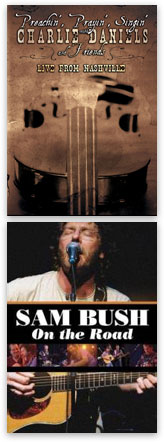 Charlie Daniels: If you would look at my iPod I have everything from Mozart to bluegrass. I just love music. The last thing I listened to was “Jerusalem Trilogy” that I recorded some time back, and I’m thinking of doing at my church next Easter.
Charlie Daniels: If you would look at my iPod I have everything from Mozart to bluegrass. I just love music. The last thing I listened to was “Jerusalem Trilogy” that I recorded some time back, and I’m thinking of doing at my church next Easter.
Sam Bush: John McLaughlin, Floating Point, his most recent record. And of course it’s through McLaughlin, the very first Mahavishnu Orchestra record, that I’ve learned Indian music. I love his Indian fusions, and he’s most inspirational. Heart live. Love them. That and Flatt & Scruggs At Carnegie Hall!, but the most that I’m glued into at this point is John McLaughlin.
EM: What was the first record you ever bought?
CD: A Fats Domino album, in about 1956. A lot of the black artists had been around for quite a while before the white world realized it. A lot of us got into the rhythm & blues-type music long before it was well-known.
SB: Bill Monroe, My All Time Country Favorites recorded with “New Mule Skinner Blues” and Bill’s second version of “Blue Moon of Kentucky.” Vassar Clements, whom I played with many times, played on “New Mule Skinner Blues” when that was recorded in 1950, before I was born. I would get to play with one of my heroes, who was on the first record I ever bought.
EM: Where do you buy your music?
CD: I buy music wherever I happen to be. I’m not much on downloading. I’ll go into a music store—any store—wherever I could be and usually I’ll buy quite a few things at a time. I buy jazz and classical, and whatever, blues, I’m a big blues fan. Mom & Pop stores usually don’t have the kind of variety that I would like. I’ll go into a Wal-Mart-type store with my wife. I’m an impulsive sort of a buyer.
SB: I’m still old-time and acoustic. I’ve never purchased online yet. I still love the thrill of going in a record store, looking at the product, and still enjoy looking at the cover and reading it. I buy almost all my music in a store in Nashville called Grimey’s, Mike Grimes’ store. I’ll probably go there later today.
EM: What was the first instrument you played?
CD: Guitar, at 14 or 15. A guy had learned a couple chords on a guitar from somewhere. He had an old Stella and played about two and a half chords, and I said, “You’ve got to show me that.”
 SB: The mandolin at age 11, a brandnew Gibson A-50, in December in 1963. I started the fiddle a couple years later. My dad played the mandolin and fiddle; my mother played the guitar; my sisters sang; music was all around.
SB: The mandolin at age 11, a brandnew Gibson A-50, in December in 1963. I started the fiddle a couple years later. My dad played the mandolin and fiddle; my mother played the guitar; my sisters sang; music was all around.
EM: What brought you to your next instruments?
CD: I got hold of a mandolin some time later on; it belonged to one of the boys in the neighborhood, and I started learning on it. The fingering on a mandolin and a fiddle are the same, of course you bow one and pick one. Then, again, someone showed up with a fiddle…it’s a little dim now, we’re talking 50-some years ago, but probably after I had been playing guitar and mandolin a little over a year.
I am not a natural musician. Things are sometimes hard for me to pick up—I have put a lot of time and effort into it, and I still do. I’m still working on the proficiency part, so I keep instruments within easy reach of where I sit. I can have a guitar in my lap in one minute.
SB: My father would listen to fiddle records, but there was always a mandolin on the record, and so for some reason the mandolin and the fiddle attracted me. Music was encouraged and loved. My parents were farmers, and never wanted me to work as hard as they did, and I don’t believe I have. All mandolin players suffer from the disease that they can play guitar as well. I suffer from it, too.
EM: Who would you like to write with that you haven’t?
CD: I could say Bob Dylan, but I don’t think Dylan lends himself to writing with other people that much, ’cause he’s such an individualist. To be honest, while I enjoy writing with people, my favorite way of writing is myself, just me.
SB: I would love to write with Nancy Wilson of Heart, and Ian Anderson… might as well include Eric Clapton in there, too.

EM: What musician influenced you most?
CD: When I fi rst started, it was the country people at the Grand Ole Opry, Elvis was the guy that made it possible for a country band to play rock, made it possible for people like me to play that kind of music. I love Charlie Parker and Stevie Ray Vaughan and B.B. King; I love Bill Monroe and Flatt & Scruggs and the bluegrass guys. I love the 1812 Overture.
SB: All in all, Bill Monroe, if there was just one. But on the mandolin, Bill Monroe and Jethro Burns (half of the comedy team of Homer and Jethro), a master musician, they hid their musicianship through comedy. On the fiddle, it would be Jean-Luc Ponty and Byron Berline; on acoustic guitar, Doc Watson; on electric guitar, Eric Clapton.
EM: What was the song or event that made you realize you wanted to be in music?
CD: I wanted to be in music for a living since before I learned how to play. I learned early on that entertainers work all the time, and if you want to make a living in the music business for 50 years, you have to learn to entertain people. Either you can be a musician, period, or you can be an entertainer. I chose early on to be an entertainer. Entertaining is how you schedule your songs onstage, you sequence your music in such a way that you take people along with you as you go. You can’t keep people in the red zone all night long, and you certainly can’t keep them in the white zone all night long, if you want to be the last thing on people’s minds. It’s a constant learning process. If you’re worth your salt, you never quit learning.
SB: A moment that was pivotal to me, when I was about 14 years of age, my father and I went down to the Grand Ole Opry, and I remember where I was sitting when I saw Bill Monroe come out with twin fiddles, and he did a song called “You’ll Find Her Name Written There,” and his guitar player was a very young Peter Rowan, and I met Peter backstage. Hearing Bill Monroe onstage at the Ryman, and it was that chillbump moment. Maybe at that moment I dreamed of playing with Bill Monroe.

EM: Who would you like in your rock and roll heaven band?
CD: Let’s start with guitar. I’m a big guitar man. I would put Duane in there. I’ve got a really good band, and I love my own drummer, Pat McDonald. Bass, probably Berry Oakley, Chuck Leavell on keyboard, he plays with the Rolling Stones now. The best white blues singer I ever heard is Gregg Allman. I never cease to marvel at what he does with his voice.
SB: Clarence White on guitar. It’s almost like I get to play in that very band right now, with Byron House on bass, Scott Vestal on banjo, Stephen Mougin on guitar, and Chris Brown (drums). That being said, I’d like to have a mandolin section with David Grisman, myself, Mike Marshall and Chris Thile. Roy Husky on bass, Stephane Grappelli and Mark O’Connor on the fiddles, Earl Scruggs and J.D. Crowe on the banjos, and over on electric guitar we could have Eric Clapton, Jeff Beck, then Jimi Hendrix and John McLaughlin. My wishes are few! Backup singers: Merry Clayton, Bonnie Bramlett. On keyboards, Jan Hammer, and Jorma Kaukonen on either acoustic or electric. And now we also have to include Bill Evans on sax; drums, definitely Chris Brown and Billy Cobham and Russ Kunkel? They don’t all have to play on every song at the same time. Did I forget Django Reinhardt? This orchestra is getting larger. The mandolin section alone…
EM: What’s your desert island CD?
CD: One of the albums would be The Allman Brothers at Fillmore East. I have an iPod with an unending supply of batteries, right? I probably listen to more blues than any other kind of music. I love Stevie Ray, and B.B. and Albert, and all the blues players. I’d probably take an 1812 Overture, a couple Charlie Parker albums. I don’t try to please anybody else but me. I like Lawrence Welk—I don’t say I listen to him all the time. There is some value in any kind of music that has lasted a long time, whether we like it or whether we don’t. It’s worked for somebody.
SB: One Man Dog, James Taylor. It’s such a beautiful album from start to finish, especially side two. It’s got John McLaughlin and just goes without stopping, and James wrote the great little instrumentals to tie it all together. That’s why Baskin Robbins makes 31 flavors.


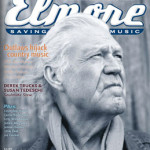
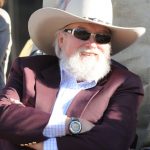
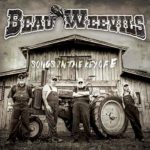
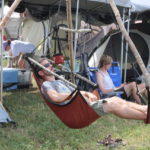

Be the first to comment!